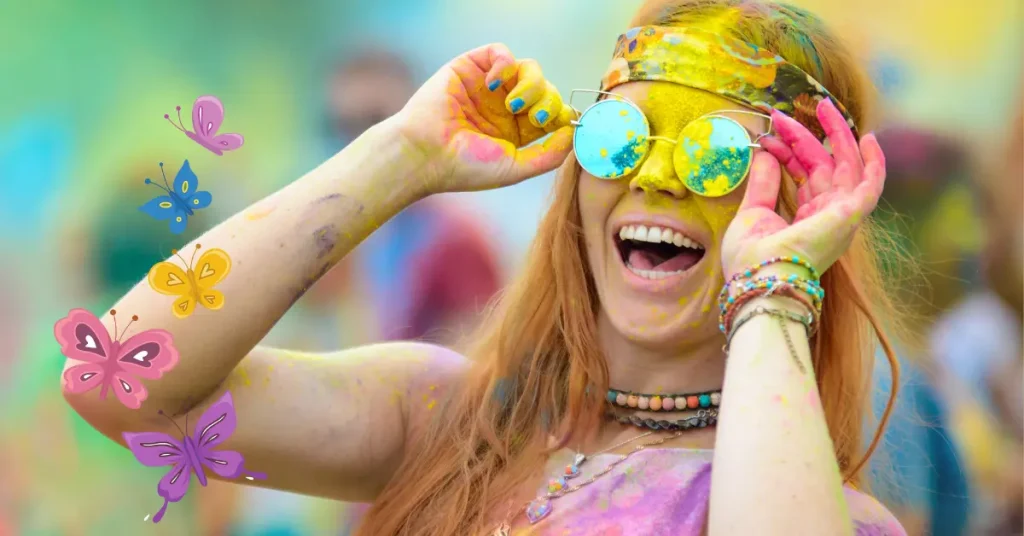Holi, also known as the Festival of Colors, is one of the most vibrant and joyous festivals celebrated in India and among Indian communities worldwide. With roots deeply embedded in Hindu mythology, this festival transcends religious boundaries and brings people together in a kaleidoscope of colors and camaraderie.

Historical Significance
Holi’s origins can be traced back to ancient Hindu texts and legends, particularly the story of Prahlada and Holika from the Puranas. It symbolizes the victory of good over evil, as depicted by the burning of the demoness Holika, signifying the triumph of devotion and righteousness over malevolence.
Preparations and Traditions
As Holi approaches, preparations begin weeks in advance. People rush to markets to buy vibrant colored powders (gulal), water guns (pichkaris), and sweets. Homes are adorned with colorful decorations, and kitchens bustle with the aroma of traditional delicacies like gujiya and thandai.
Rituals and Customs
The festivities kick off with Holika Dahan, where bonfires are lit to commemorate the burning of Holika. The following day, revelers take to the streets, smearing each other with colors and dousing one another with water. It’s a day of uninhibited joy and merriment, as old grievances are forgotten, and bonds are strengthened.
Cultural Significance
Beyond its religious roots, Holi holds cultural significance as a time to mend relationships and celebrate unity. It’s a day when social norms are relaxed, and people from all walks of life come together to revel in the spirit of camaraderie.
Holi Around the World
While Holi is predominantly celebrated in India and Nepal, its popularity has spread globally. From the streets of New York City to the beaches of Australia, people of various cultures partake in the festivities, embracing the colors and spirit of this joyous occasion.
Modern Celebrations
In recent years, Holi celebrations have evolved to include extravagant parties and events, both in-person and virtual. Social media platforms buzz with Holi-themed content, showcasing the festival’s exuberance to a global audience.
Health and Safety Concerns
Amidst the revelry, it’s essential to prioritize health and safety. Skin and eye protection are crucial, given the harsh chemicals present in some colors. Additionally, responsible water usage and eco-friendly alternatives are encouraged to minimize environmental impact.
Holi and Unity
Holi serves as a powerful symbol of unity, transcending barriers of caste, creed, and religion. It’s a time to embrace diversity and celebrate the richness of human connections, fostering a sense of community and solidarity.
Read also: Carlos Sainz Clinches Victory for Ferrari in Australian F1 2024 Grand Prix, Securing One-Two Finish
Personal Experiences
For many, Holi holds cherished memories of childhood innocence and familial bonds. From playful water fights to indulgent feasts, each tradition adds a layer of warmth and nostalgia to the festivities.
Holi in Literature and Art
Throughout history, Holi has inspired countless works of literature, art, and cinema, capturing its essence through vivid imagery and storytelling. From ancient texts to modern interpretations, Holi’s influence permeates various forms of creative expression.
Holi in the Digital Age
In the digital age, Holi celebrations have transcended physical boundaries, with virtual gatherings and online events allowing people worldwide to partake in the festivities. Social media platforms overflow with Holi-themed posts, connecting individuals in a virtual tapestry of colors.
Future of Holi
As societal dynamics shift and globalization continues to influence cultural traditions, the future of Holi remains dynamic and ever-evolving. While the core essence of the festival remains unchanged, its expressions may adapt to reflect contemporary sensibilities.
Conclusion
Holi, the Festival of Colors, encapsulates the vibrancy and diversity of Indian culture. Beyond its religious origins, it serves as a timeless celebration of unity, joy, and human connection. As we embrace the spirit of Holi, let us cherish the bonds that unite us and revel in the kaleidoscope of colors that paint our world.
Q: Can anyone participate in Holi celebrations?
A: Absolutely! Holi is a festival for everyone, regardless of age, gender, or background. It’s a time to come together and celebrate the joy of life.
Q: Are there any religious rituals involved in Holi?
A: While Holi has religious significance for Hindus, many non-Hindus also participate in the festivities purely for the joy of celebration.
Q: How can I celebrate Holi in an eco-friendly way?
A: Opt for natural colors made from plant extracts, minimize water usage, and avoid wasteful practices like balloon releases. Embracing eco-friendly alternatives ensures a sustainable celebration.
Q: Is it safe to participate in Holi during the COVID-19 pandemic?
A: Given the risk of transmission, it’s essential to follow local health guidelines and prioritize safety measures such as mask-wearing and social distancing. Consider celebrating with close family members or virtually.
Q: What’s the best way to remove Holi colors from the skin and hair?
A: Gentle cleansing with mild soap and lukewarm water is effective in removing colors from the skin. For hair, opt for a nourishing shampoo followed by a deep conditioning treatment to restore moisture.